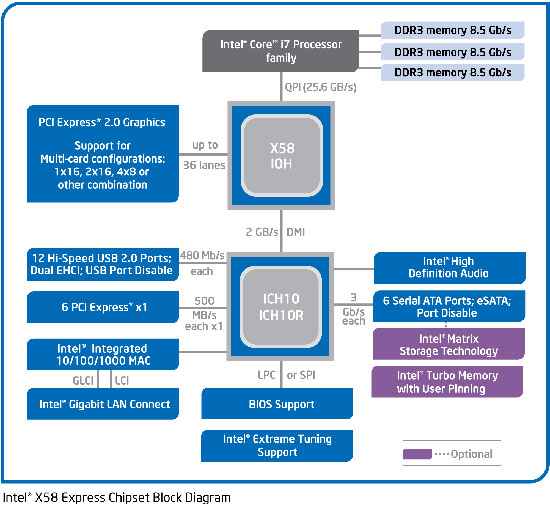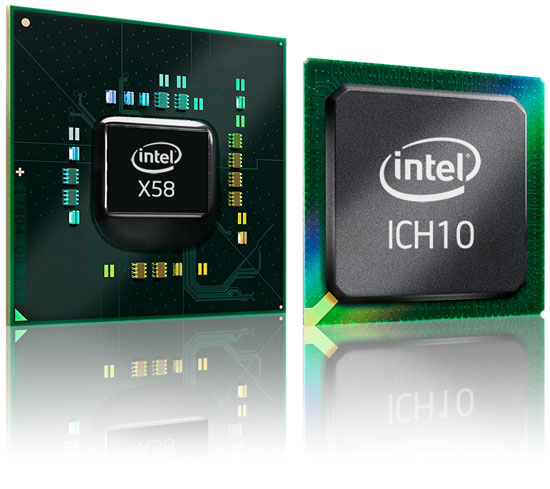The Dark Knight: Intel's Core i7
by Anand Lal Shimpi & Gary Key on November 3, 2008 12:00 AM EST- Posted in
- CPUs
The Chipset - Meet Intel's X58
Nehalem moves the North Bridge and memory controller on-die, but just like in the AMD world there's still a need for an off-die chipset, in this case it's Intel's brand new X58.
The Intel X58 chipset is a two chip solution although later next year Intel will introduce a single chip solution alongside the mainstream version of Nehalem (which will use a different socket). Traditionally Intel referred to its North Bridge as the MCH, shorthand for Memory Controller Hub; that definition no longer applies to Nehalem so X58 is called an I/O Hub (IOH).

The X58 IOH attaches to the same ICH10 (I/O Controller Hub) that is used in Intel's 4-series chipsets.

The biggest feature of X58 is that with proper "certification" by NVIDIA, motherboard makers can include support for the right BIOS flags to allow NVIDIA's drivers to enable SLI on the platform. Meaning the X58 will be the first Intel chipset to support both CrossFire and SLI multi-GPU solutions without the use of any NVIDIA silicon. There's a per-motherboard fee from NVIDIA for each certified X58 board sold and thus not all boards will be certified, the most prominent of which is Intel's own X58 board. Luckily we also had access to ASUS' P6T Deluxe which is certified, giving us the ability to look at CrossFire and SLI scaling on X58 vs. other platforms.










73 Comments
View All Comments
Gary Key - Monday, November 3, 2008 - link
"The 920 to 3.6/3.8 is a nice overclock but I wonder what you mean by proper cooling and how close you came to crossing the 80C "boundary"?"It was actually quite easy to do with the retail cooler, in fact in our multi-task test playing back a BD title while encoding a BD title, the core temps hit 98C. Cinebench multi-core test and OCCT both had the core temps hit 100C at various points. Our tests were in a closed case loaded out with a couple of HD4870 cards, two optical drives, three hard drives, and two case fans.
Proper cooling (something we will cover shortly) consisted of the Thermalright Xtreme120, Vigor Monsoon II, and Cooler Master V8 along with the Freezone Elite. We were able to keep temps under 70C with a full load on air and around 45C with the Freezone unit.
Th3Eagle - Tuesday, November 4, 2008 - link
Wow, thats interesting. Can't wait to see the new article. Always nice to see an article about coolers.Thanks for the reply.
Anand Lal Shimpi - Monday, November 3, 2008 - link
Gary did the i7-920 tests so I'll let him chime in there, we're also working on an overclocking guide that should help address some of these concerns.-A
whatthehey - Monday, November 3, 2008 - link
Tom's? You might as well reference HardOCP....Okay, THG sometimes gets things right, but I've seen far too many "expose" articles where they talk about the end of the world to take them seriously. Ever since the i820 chipset fiasco, they seem to think everything is a big deal that needs a whistle blower.
Anandtech got 3.8GHz with an i7-920, and I would assume due diligence in performance testing (i.e. it's not just POSTing, but actually running benchmarks and showing a performance improvement). I'm still running an overclocked Q6600, though, and the 3.6GHz I've hit is really far more than I need most of the time. I should probalby run at 3.0GHz and shave 50-100W from my power use instead. But it's winter now, and with snow outside it's nice to have a little space heater by my feet!
The0ne - Monday, November 3, 2008 - link
TomHardware and Anandtech were the one websites I visited 13 years ago during my college years. Tom's has since been pushed far down the list of "to visit sites" mainly due to their poor articles and their ad littered, poorly designed website. If you have any type of no-script enable there's quite a bit to enable to have the website working. The video commentary is a joke as they're not professionals to get the job done professionally...visually anyhow.Anandtech has stayed true to it's root and although I find some articles a bit confusing I don't mind them at all. Example of this are camera reviews :)
GaryJohnson - Monday, November 3, 2008 - link
Geez, calling a core 2 a space heater. How soon we forget prescott...JarredWalton - Monday, November 3, 2008 - link
I think overclocked Core 2 Quad is still very capable of rating as a space heater. The chips can easily use upwards of 150W when overclocked, which if memory serves is far more than any of the Prescott chips did. After all, we didn't see 1000W PSUs back in the Prescott era, and in fact I had a 350W PSU running a Pentium D 920 at 3.4 GHz without any trouble. :-)Griswold - Tuesday, November 4, 2008 - link
Funny comparison. If it was just for the space heater arguments sake (well, 150W is by far not enough to qualify as a real space heater to be honest), I could follow you but saying the 150W of a 4 core, more-IPC-than-any-P4-can-ever-dream-of, processor should or could be compared to the wattage of the infamous thermonuclear furnace AKA prescott, is a bit of a long stretch, dont you think? :pRyan Smith - Monday, November 3, 2008 - link
Intel can call it supercalifragilisticexpialidocious until they're blue in the face, but take it from a local, it's Neh-Hay-Lem. Just see how it's pronounced in this news segment:http://www.katu.com/outdoors/3902731.html?video=YH...">http://www.katu.com/outdoors/3902731.html?video=YH...
mjrpes3 - Monday, November 3, 2008 - link
Any chance we'll see some database/apache benchmarks based on Nehalem soon?